Anirudh Kanisetti
The concept of cyclical time, of eras, of patterns repeating themselves, is an integral part of many Indian religious traditions, from Buddhism to Hinduism. But this observation is not unique to the Indian subcontinent. Grand cycles of anarchy, consolidation, apex, and decline have been observed by scholars ranging from Polybius to Ibn Khaldun.
Yet despite these cycles, it appears that ancient India, to a degree, was resilient to them. Despite the common assumption of India as being a volatile and fractured land, there is a surprising degree of civilisational continuity. Dynasties came and went, cultural Golden Ages came and went, and periods of anarchy came and went. Yet some dynasties reigned for hundreds upon hundreds of years, the subcontinent remained a major entrepot for global trade, and some millennia-old cultural traditions are still around.
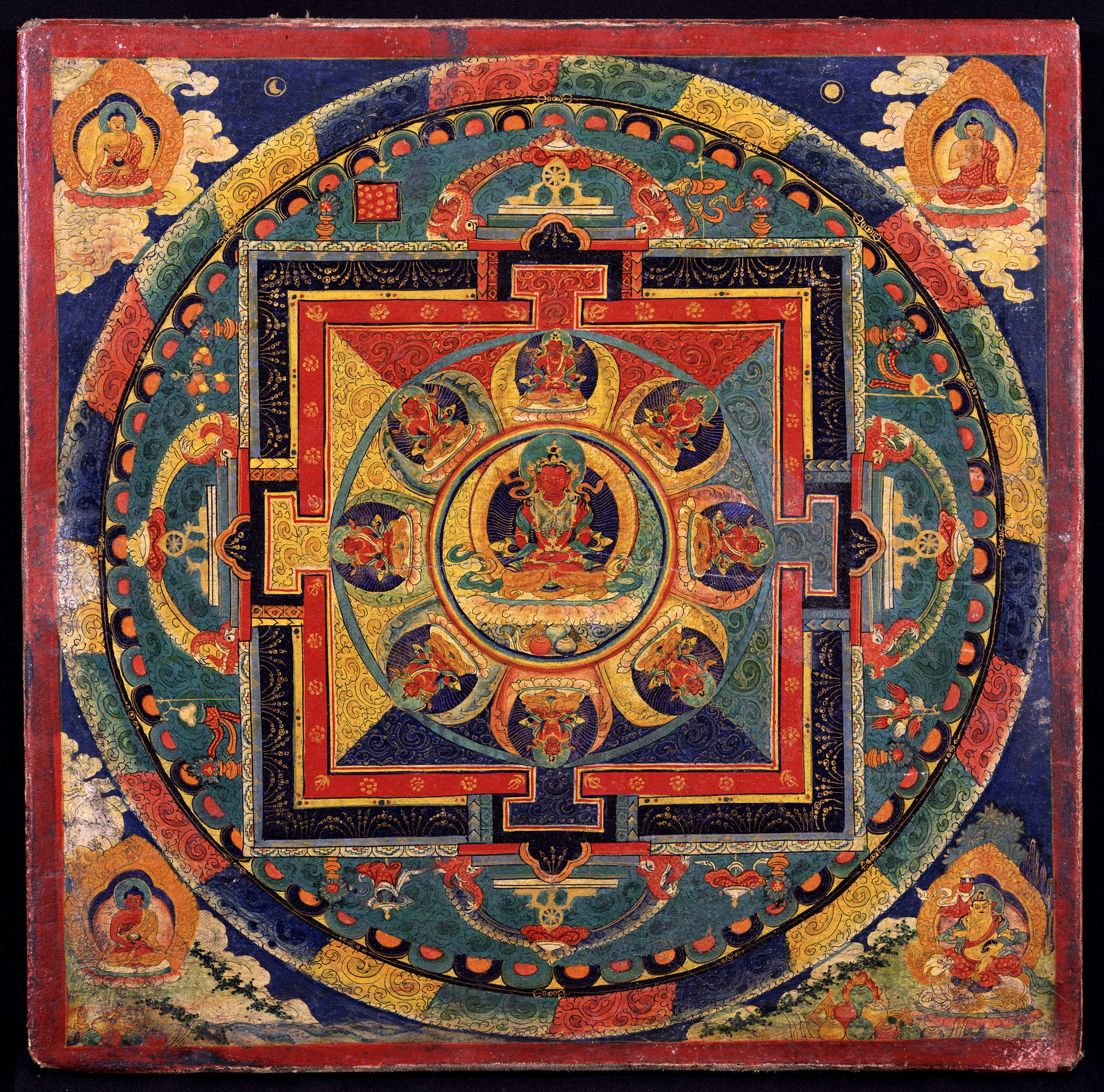 In this essay, I aim to answer the question of what causes these cycles, and situate them within the context of India’s history.
In this essay, I aim to answer the question of what causes these cycles, and situate them within the context of India’s history.
Agrarian Cycles
In the late 18th century, the English scholar Robert Malthus argued that the linear of growth of agricultural surplus, when it lagged behind the exponential growth of population, would cause famine. The reduced population would now have an agricultural surplus and grow again, restarting the cycle. This, it was theorised, was the cause of the stagnation of the European population and economy in the 13th and 14th centuries.
Marxist historians, however, argued that the stagnation was a result of a large feudal aristocracy extracting too much of the surplus produced by presents, hindering growth until gunpowder enabled states to centralise and dispose of feudalism.
In their fascinating Secular Cycles (2009), Peter Turchin and Sergey Nefedov move towards an explanation of the cycles of history by integrating the two views. Populations put pressure on resources, but elites put pressure on populations. By studying the growth and decline of both, they discover slow cycles with a period of around 200–300 years.
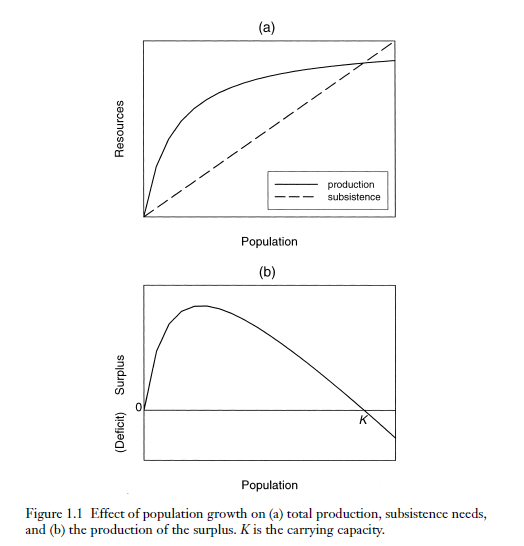 Resources and population growth diagrams from Turchin and Nefedov’s “Secular Cycles”. Carrying capacity is the maximum population sustainable by a given environment.
Resources and population growth diagrams from Turchin and Nefedov’s “Secular Cycles”. Carrying capacity is the maximum population sustainable by a given environment.
The logic is simple. Initially, as the population grows, it has more agricultural workers, so it is able to extract more resources than it needs for subsistence. This gives it the surplus it needs to grow faster. But beyond a point, each additional unit of the population can extract less resources (because land is limited). So the surplus reduces. (Phase I: Expansion.)
As there is less agricultural surplus to go around, workers move to the cities. This increases the amount of labour available, driving down wages. Elites are therefore able to produce and consume more luxury goods, causing a “Golden Age”. (Phase II: Stagflation.) This drives up prices. Some peasants grow wealthy, whereas some elites grow poor. There is social friction and a general growth in the size of the elite — but the surplus is limited. The elite therefore begins to compete, leading to civil war and the weakening of the state. (Phase III: Crisis.) The population declines, and the cycle eventually resets itself. (Phase IV: Depression.)
The Indian Case
Prof Turchin points out that the period of the cycle is not fixed, and is mediated by a host of factors. The first phase depends on what the starting population was, and the growth rate. The third phase depends on how rapidly the elite grows, and how much surplus they are capable of extracting. The fourth phase depends on whether there is an “integrative” trend to reform a state, or an external power that will conquer it and reset the cycle.
I propose a few India-specific alterations to the theory. Due to the fragmented nature of the sources, these are, at this point, purely conjectural, and encompass a variety of social and cultural conditions across time and space.
Phase I: Expansion. India has a tropical climate with a high “carrying capacity” — the population that a given ecology can support. This is likely to be higher in the fertile plains of the Ganga as well as the coastal flatlands of Tamilakam. A considerable degree of decentralisation is attested to till at least the medieval period. Agricultural populations would perhaps have been relatively high, and not substantially affected by political volatility.
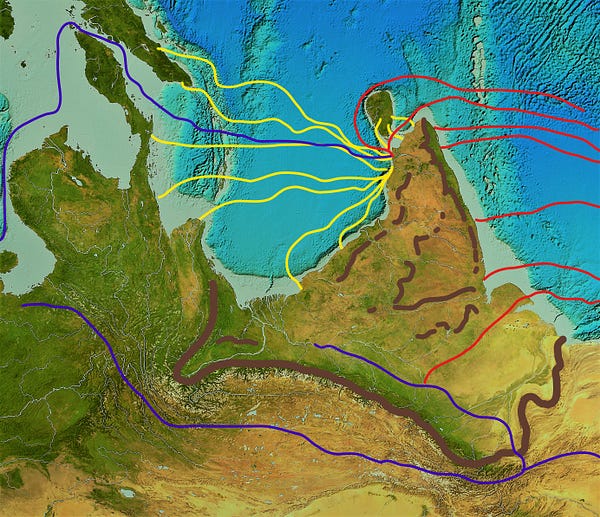 India, with terrain and trade routes highlighted.
India, with terrain and trade routes highlighted.
2. Phase II: Stagflation. The theory was developed using European data. Europe was not a major global trading region between the Roman and early modern periods. India, however, was geographically at the centre of global trade. Elites were consistently tapped into a source of surplus. Further, caste and merchant guilds placed limits on who could produce what — possibly keeping wages and prices from fluctuating too wildly.
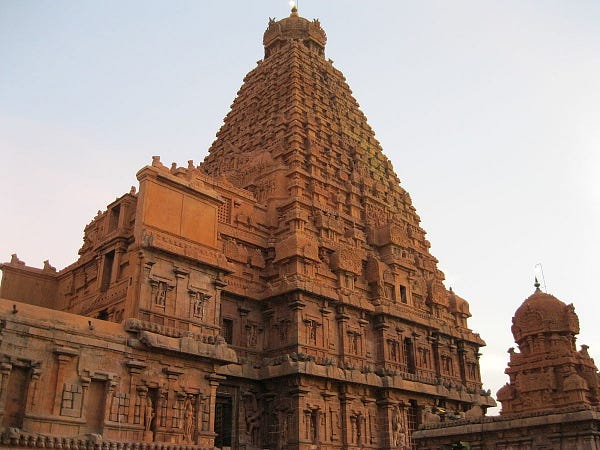 The massive Brihadesvara temple would have provided jobs to thousands in the day, and was funded by wealth from the elites. (Source: Wikimedia Commons/ SK Chulunpur)
The massive Brihadesvara temple would have provided jobs to thousands in the day, and was funded by wealth from the elites. (Source: Wikimedia Commons/ SK Chulunpur)
3. Phase III: Crisis. The caste system could have acted as a social “safety valve” which allowed the elite to expand (through the enactment of Vedic rituals) or retain status (by substituting social capital for actual capital). Trade surpluses were consistently high. States indulged in redistributionthrough the construction of temples.
Furthermore, the decentralised nature of Indian states and the wide geographical variance of the subcontinent made it difficult to consistently extract surplus.
In addition, periods of high social friction usually led to calls for religious reform led by charismatic preachers (such as the Buddha). This could have removed some of the working-age population from circulation, acting as another safety valve.
4. Phase IV: Depression. The ideas of “nationhood” as applied to a tribal or linguistic identity were different in India as compared to Europe. For example, European kings would refer to themselves as “King of the Franks” or “Emperor of the Romans”. If one dynasty declined, another would claim title A or title B.
Indian kings, on the other hand, would generally use non-specific titles such as “Great King-of-Kings” or “Pinnacle of His Family”. Integrative trends towards a centralised state were therefore weaker — if an empire collapsed, it would remain so until a dynasty gained enough power to rebuild the administration.
To summarise: Phase I is shorter as the agrarian population is generally high; Phase II & 3 are longer and less destructive due to cultural and economic reasons; Phase IV is longer due to the relative lack of integrative trends.
Reflections
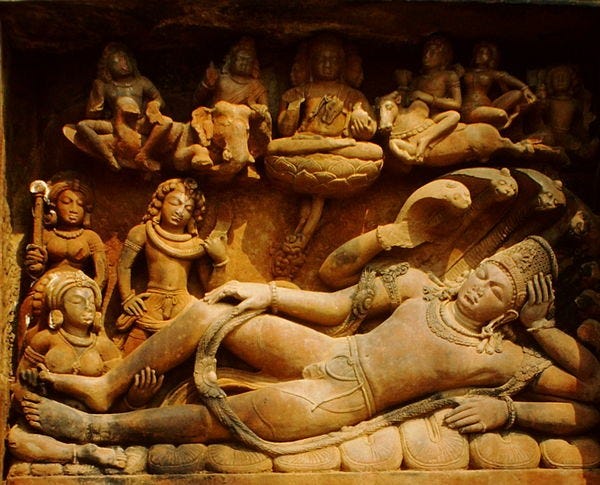 A Gupta Vishnu, from the temple at Deogarh. In many stories, the god rests for aeons before coming to Earth to rescue humans from the periodic ravages of demons.
A Gupta Vishnu, from the temple at Deogarh. In many stories, the god rests for aeons before coming to Earth to rescue humans from the periodic ravages of demons.
At a general level, one would expect that Indian cycles initially take time to kick off, but once the engine starts, prosperity lasts for considerable periods of time, until unseated by successive internal or external crises or overextension — as seen in the case of the Chola and Mughal periods. Once the cycle enters a depression phase, if there is an integrative trend — perhaps motivated by external crisis (as in the case of Vijayanagar) or weakened neighbours (as in the case of the Guptas) — it is easy to move rapidly back into expansion and stagflation (“Golden Age”) phases. But if there isn’t, states remain fragmented for longer. Perhaps this could be a reason for the stupendous scales of Indian cosmology, and the ubiquitous motif of cyclical time.
Since certain Indian cultural institutions contributed to the stability of the cycles, they stuck around for long periods of time, usually being reformulated to meet the specific conditions of a given cycle. In addition, broader global trends often played an important role. South India’s first major integrative trends were caused due to trade surpluses arising from the Greek and later Roman conquests of Egypt. The weakness of North Indian principalities which allowed for Gupta expansion was caused by the conquests of the Kushans, which in turn was sparked off by the Chinese campaigns against the Xiongnu centuries earlier. The wealth of the Mughal Empire stemmed from its connection to trade with the other early modern Islamic gunpowder empires.
Prof Turchin’s theory of secular cycles, while not perfect for understanding India’s past, is nevertheless a valuable framework for analysis. Further archaeological and numerical data is required in order to substantiate my proposed adjustments. However, as a general theory, it provides a useful explanation for the grand cycles of our past, and explains the surprising continuity of our cultural institutions.
No comments:
Post a Comment